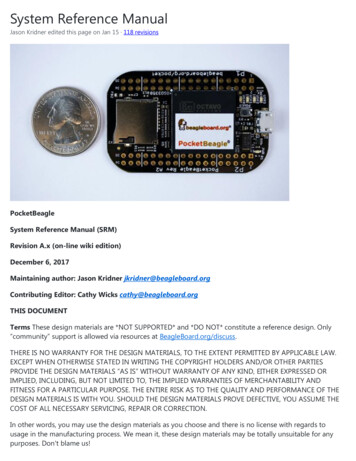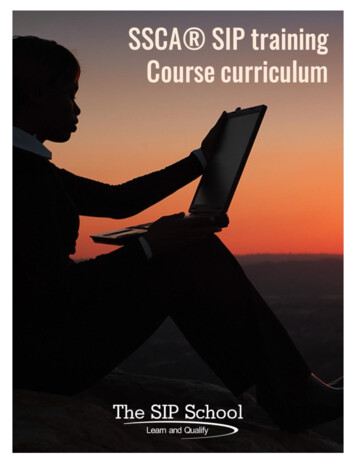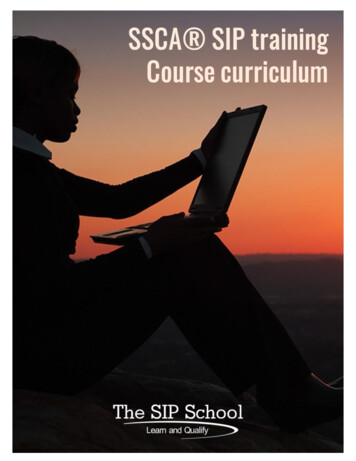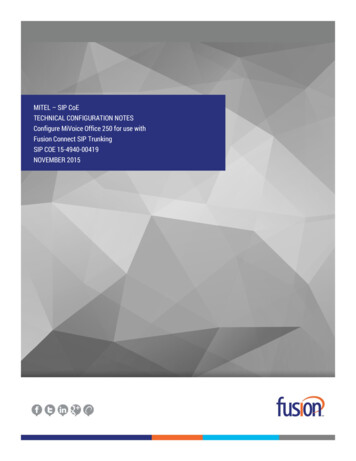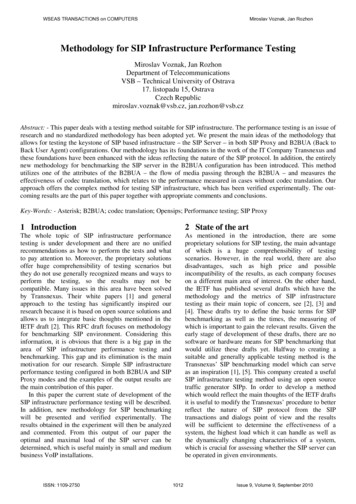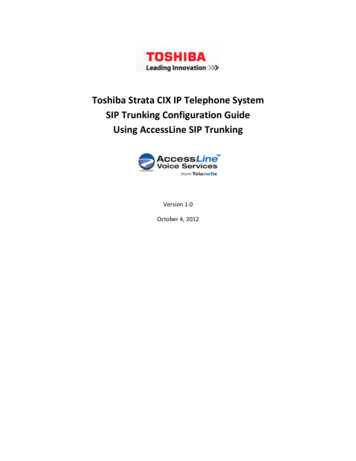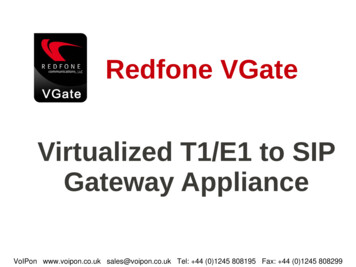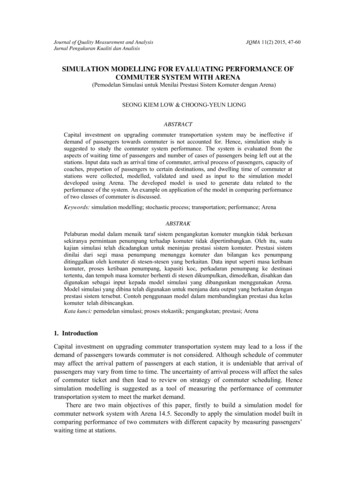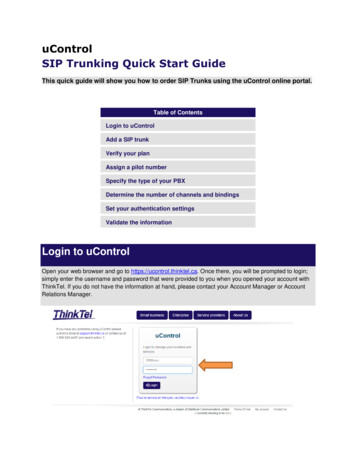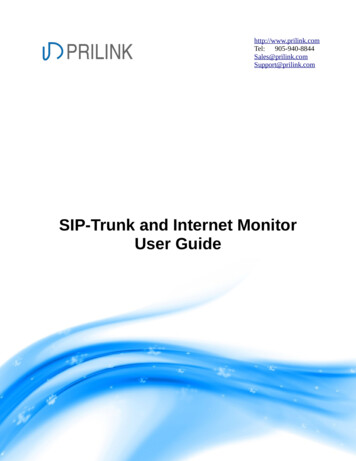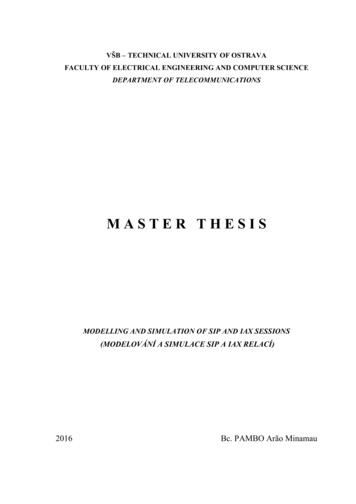
Transcription
VŠB – TECHNICAL UNIVERSITY OF OSTRAVAFACULTY OF ELECTRICAL ENGINEERING AND COMPUTER SCIENCEDEPARTMENT OF TELECOMMUNICATIONSMASTER THESISMODELLING AND SIMULATION OF SIP AND IAX SESSIONS(MODELOVÁNÍ A SIMULACE SIP A IAX RELACÍ)2016Bc. PAMBO Arão Minamau
2
DECLARATIONI hereby declare that I have worked this thesis on my own. I have referenced all the literarysources and publications that I have used.In Ostrava, on June 29th 2016. Student’s signature3
ACKNOWLEDGENTSI would like to thank my supervisor Assoc. Prof. Doc. Ing. Miroslav Vozňák, PhD. for hisguidance, comments, hours of fruitful discussions and also for drawing my attention to theVoIP technology, mainly to the SIP and IAX protocols.4
ABSTRACTMy thesis is focused on simulating a functioning model of SIP and IAX and compare thesetwo VoIP protocols. This is done by implementing an Asterisk server onto two virtualmachines with Ubuntu operating system where I build a trunk system for both protocol, testedit by calling the peers in both directions, captured the traffic passing through and analyzed itwith Wireshark. The acquired data is then implemented and presented on a chart form for abetter view and comparison of the two parallel protocols.KEY WORDS: VOIP, SIP, IAX, TRUNKING, ASTERISK, RTP, SRTP, UDP,BANDWIDTHABSTRAKTMoje práce je zaměřena na simulaci funkčnosti modelu SIP a IAX a porovnání těchto dvouVoIP protokolů. To je provedeno zavedením Asteriskem serveru na dva virtuální počítaček soperačním systémem Ubuntu, kde je vybudován trunk systém pro oba protokoly a to tak, žespojuje volající v obou směrech, zachycuje průchod a analyzuje pomocí Wireshark. Získanádata jsou pak použita a prezentována ve formě grafů pro lepší přehlednost a srovnání obouparalelních protokolů.KLÍČOVÁ SLOVA: VOIP, SIP, IAX, TRUNKING, ASTERISK, RTP, SRTP, UDP,BANDWIDTH5
CONTENTS1 INTRODUCTION TO VOICE OVER IP AND SIP PROTOCOL . . . . 91.1 Advantages of VoIP. . . . .111.2 Drawbacks of VoIP . . . . .131.3 Understanding the Session Initiation Protocol – SIP. . . . . .161.3.1 SIP Security Abilities. .171.3.2 SIP definitions . . . 182. ASTERISK AND ITS NATIVE PROTOCOL IAX 252.1 Asterisk Definition . . .252.1.1 Asterisk architecture . .252.1.2 Modules . . . 262.1.3 Types of Modules in Asterisk. . . . . .272.1.3.1Applications Module . . . 272.1.3.2Bridging Modules . . .272.1.3.3Call Detail Recording – CDR Modules . .272.1.3.4Channel Event Logging Modules – CEL . .282.1.3.5Channel Drivers .282.1.3.6Codec Translators .282.1.3.7Format Interpreters .282.1.3.8Dialplan Functions .292.1.3.9PBX Modules .292.1.3.10Resource Modules .292.2.1 Configuration of backends . . . .292.2.2 Timing interfaces . 292.2.3 Calendar integration . .292.2.4 RTP Implementations . .302.2.5 Configuration Files . . . . .302.2.6 Logging Files . . 302.2.7 Asterisk Dial Plan . .312.3The Hardware for Asterisk . . .322.3.1 Asterisk Installation . . . . .326
2.4Inter Asterisk eXchange – IAX . .342.4.1IAX: Towards Lightweight Telephony Architectures . . .362.4.2Solving VoIP Problems with IAX . . .382.4.3IAX Ensures Reliability . .392.4.4Registering IAX . .392.4.5Transportation of Media Streams in IAX . . .402.4.6IAX Codec Negotiation . . .402.4.7IAX and Security Related Issues . . 402.4.8Advantages of IAX . . . . .402.4.9IAX Full Frames .442.4.10 IAX Communication Call Flow 472.5Comparison of Main Differences of SIP vs IAX Protocols .483. BUILDING TRUNKS BETWEEN ASTERISK BASED ON SIP AND IAX . 504. MEASUREMENT OF TRAFFICS ON SIP AND IAX SESSIONS .574.1SIP Installation . .575. DESIGN AND IMPLEMENTATION OF THE SIMULATION MODEL FOR SIPAND IAX TRAFFIC . . .635.1 SIP Model . . .635.2 IAX Model. . .636. CONCLUSION . . .65LITERATURE . . .66ACRONYMS . . .68LIST OF TABLES .70LIST OF FIGURES 71LIST OF GRAPHS .72APPENDIX . 737
INTRODUCTIONVoice over Internet Protocol (VoIP) has been prevailing in the telecommunication world sinceits emergence in the late 90s as a new technology transporting multimedia over the IPnetwork. It is very common today for people to make phone calls with IP phones or clientsoftware (e.g. Skype, iChat, and Google Talk) on their computer. Many telecommunicationscompanies and other organizations have been moving their telephony infrastructure to theirdata networks, because it provides a cheaper and clearer alternative to traditional publicservice telephone network (PSTN) phone lines.Even though the VoIP service is getting popular, its technology is still developing. Itsdeployment throughout the world is much faster than at the time of the traditionaltelecommunication system, though it often lacks compatibility and scalability with existingsystems. Nevertheless, VoIP has already conquered a significant pie of the telephony market,given the fiscal savings and flexibility that it can provide. In this thesis, I will focus on theSIP and IAX as two major protocols of this technology.88
1. INTRODUCTION TO VOICE OVER IP AND SIP PROTOCOLVoice over IP (VoIP) is a technology for the delivery of voice communications andmultimedia sessions over an IP (Internet Protocol) network, such as the Internet [5]. The VoIPtechnology allows many benefits for customers and communication services providers. Infact, the VoIP approach allows the reduction of calls and communication infrastructure costs,helps the provision of new communication services (instant messages, video calls, imagestransfer, etc.), ensures users and services mobility, allows the integration and collaborationwith other applications (email, web browser, instant messenger, social networkingapplications), and provides an online tracking and managing system.Nowadays, Voice over Internet Protocol (VoIP) constitutes a privileged field of serviceinnovation. One benefit of the VoIP technology is that it may be deployed using a centralizedor a distributed architecture. The majority of today‟s VoIP systems are deployed using theclient–server centralized architecture. One of the most efficient approaches used in thedeployment of centralized VoIP systems is based on the use of IAX (Inter-AsteriskExchange), which is an open-source signaling and/or data exchange protocol.Even though they are currently and widely used, client-server VoIP systems suffer from manyweaknesses such as the presence of single points of failure, an inefficient resourcesmanagement, and system non-scalability. In order to cope with the development of scalableand reliable VoIP systems, the development community tends towards the deployment of theVoIP service using a peer-to-peer distributed architecture. The goal of this project is toinvestigate the behavior of IAX protocol, provide comparison to SIP and implement asimulation model for SIP and IAX traffics.Since corporation started using digital voice coding, such as Integrated Service DigitalNetwork – ISDN, they have thought about convergence between telephony and ITenvironment in order to transmit data, voice and video applications using one and the samemedium. Unfortunately, each of these applications has different needs.Data transmission requires different line bandwidths and does not care for reliability ofconnection, and, on the opposite, voice and video transmissions need a constant bandwidthand guaranteed time of delivery.9
The structures of available networks are different and only meet the needs of the applicationthey have been created for. In data networks, everyone can use the available bandwidth to themaximum extent, which means that the line capacity is exploited efficiently. On the contrary,telephone network reserves a channel per call regardless of data transmission (e.g. one party isspeaking only during a standard call, there is no data transmission from the non-speakingparty but the channel remains busy).A lot of voice and video transmission technologies using real-time IP networks (Internet),generally called VoIP (Voice over IP), have been developed as an alternative to the standardcircuit-switching telephone network. As a result of natural selection, only two of them arenow implemented in telecommunications, which improves interaction and compatibility ofproducts from different companies. These two technologies are H.323 and SIP (RFC rporation IM/PresenceCallManagerCorporation IM/PresenceFig. 1 – VoIP service architecture with many different types of services integrated [15]10
1.1 – ADVANTAGES OF VoIPThe reason for the prevalence of VOIP is that it gives significant benefits compared to legacyphone systems. The key benefits are as follows [6]: Cost savings – The most attractive feature of VoIP is its cost effectivepotential. When we move away from public switched telephone networks, longdistance phone calls become inexpensive. Instead of being processed acrossconventional commercial telecommunications line configurations, voice traffictravels on the Internet or over private data network lines.For the companies, VoIP reduces cost for equipment, lines renting, manpower, andmaintenance. All of an organization's voice and data traffic is integrated into one physicalnetwork, bypassing the need for separate Private Branch eXchange – PBX tie lines. Althoughthere is a significant initial setup cost, significant net savings can result from managing onlyone network and not needing to sustain a legacy telephony system in an increasingly digitaland data-centered world. Also, the network administrator's burden may be lessened as theycan now focus on a single network. There is no longer a need for several teams to manage adata network and another to manage a voice network. For consumers, VoIP reduces thecharge of subscription or usage, especially for long distance and international calls. Rich media service – The legacy phone system mainly provides voice and faxservices even though limited video service is also possible. However, users‟demands are much higher than that, as shown in today's rich mediacommunications through the Internet. People check out friends' presence (suchas online, offline, busy status), send instant messages, make voice or videocalls, transfer images, etc. VoIP technology makes rich media service possible,integrating with other protocols and applications.Rich media service does not only provide multiple options of media to users, but also createsnew markets in the communications industry, such as VoIP service in mobile phones. Phone portability – The legacy phone system assigns a phone number with adedicated line, this means that technically a user cannot move the home phoneto another place if they still want to use the very phone number. It is a common1111
issue to call the phone company and ask for a phone number update whenmoving to a new house. However, VoIP provides number mobility: The phonedevice can use the same number virtually everywhere as long as it has properIP connectivity. Many businesspeople today care along their IP phones orsoftphones when traveling and use the same numbers everywhere. Service mobility – The context of mobility here comprehends serviceavailability for the customer at any place they move. Wherever the phone goes,the same services could be available, such as call features, voicemail access,call logs, security features, service policy, etc. Integration and collaboration with other applications – VoIP protocols (suchas Session Initiation Protocol – SIP, H.323) (RFC 4123) run on the applicationlayer and are able to integrate or collaborate with other applications such asemail, web browser, instant messenger, social networking applications, andmore. The integration and collaboration create synergy and provide valuableservices to the users. Typical examples are voicemail delivery via email, clickto-call – C2C service on a website, voice call button on an email, presenceinformation on a contact list, etc. User control interface – Most VoIP service providers provide a user controlinterface, typically a web GUI, to their customers so that they can changefeatures, options, and services dynamically. For instance, the users log in to theweb GUI and change call forwarding number, speed dial, presence information(online/offline status), music-on-hold option, anonymous call block and more. No geographical boundary – The VoIP service area becomes virtualizedwithout geographical limits. That is, the area code or country code is no longerbound to a specific location. For instance, a given customer could live inPrague and subscribe to a USA phone number, which makes it possible that allcalls to the USA become domestic calls (cheaper) even though the customerlives in the Czech Republic. Rich features – VoIP provides rich features like click-to-call on a web page,Find-Me-Follow-Me (FMFM), selective call forwarding, personalized ringtones (or ring back tone), simultaneous rings on multiple phones, selective areaor country code, etc.1212
These significant benefits are behind the prevalence of VoIP compared to legacy phonesystems. In fact, most service providers have already started or at least have planned tomigrate their PSTN (Public Switched Telephone Network) infrastructure to an IP-based one,thus showing a signal of future telephony systems to be totally IP based and the CircuitSwitched (core voice system) would be no longer needed.One benefit of the VoIP technology is that it may be deployed using either a centralized or adistributed architecture. The majority of today‟s VoIP systems are deployed using a clientserver centralized architecture, which is a system that relies on the use of a set ofinterconnected central servers responsible for the registration of users, and the management ofVoIP sessions between these [5].Different signaling protocols have been proposed for the deployment of client-server VoIPsystems such as the ITU-T H.323 Session Initiation Protocol – SIP (RFC 3261), and the InterAsterisk eXchange – IAX (RFC 5456).The current VoIP systems do mainly rely on the use of SIP and IAX signaling protocols. Eventhough it was proposed for security and flexibility purposes, SIP (RFC 3261) suffers frommany weaknesses. In fact, nowadays SIP becomes more and more complex due to theincremental modification of SIP specifications in order to improve the protocol adaptability.Moreover, SIP suffers from the difficulties of crossing NAT (Network Address Translation)and firewall boxes. IAX (RFC 5456) protocol is considered as a possible candidate to solveSIP problems as it is a robust protocol which supports NAT and firewalls traversal since no IPaddresses are enclosed in IAX (RFC 5456) signaling messages.Moreover, IAX (RFC 5456) allows signaling and data traffic exchange in contrast with SIPwhich is limited to the signaling task.1.2 – DRAWBACKS OF VoIPThe benefits of VoIP do not come free of charge. There are significant disadvantages forusing VoIP, and I will name some:1313
Complicated service and network architecture – Integrated rich mediaservices (such as voice, video, IM, presence, and fax) make it difficult todesign the service and network architecture because many different types ofdevices for each service are involved, as well as different protocols andcharacteristics of each media. Rich features such as click-to-call and find mefollow me (C2C, FMFM) also make the architecture more complicatedbecause many different applications (such as web and email) and platforms areinvolved. This complication requires extra time and resources when designing,testing, and deploying. It also causes several errors and makes it harder fortroubleshooting and isolate them. Interoperability issues between different protocols, applications, or products– There are multiple VoIP protocols (such as SIP, H.323, Media GatewayControl Protocol – MGCP), and product companies which choose whateverthey like when developing products, which means there are alwaysinteroperability issues between the products that use different protocols. Evenbetween the products using the same protocol, interoperability issues still comeup because of different ways of implementation, different versions(extensions), or different feature sets. Therefore, it is common for VoIP serviceproviders to spend a significant amount of time and resources for testinginteroperability and resolving related issues. Quality of service (QoS) – Voice and video streams flow over an IP networkas real-time packets, passing through multiple networks and devices (such asswitches, routers, firewalls, and media gateways). Therefore, ensuring QoS isvery difficult and costs lots of time and resources to meet the user'sexpectations. The main factors in QoS are packet loss, delay, and jitter (packetdelay variation). Power outages – Legacy home phones continue to work even during a poweroutage because the phone line supplies 48 volts constantly. However, VoIPphones use regular data network lines that do not provide power in most cases,which means we cannot use VoIP phones during power outages. Yet, there areinline power solutions (such as Power over Ethernet), but these are mainly forenterprise environments.1414
Security issues – In a legacy phone system, the security issue is mainlyintercepting conversations that require physical access to phone lines orcompromise of the office PBX. In VoIP based on open or public networks,security issues are much more than that. Between a caller and callee, manyelements (such as IP phones, access devices, media gateways, proxy servers,and protocols) are involved in setting up the call and transferring the media.Each element has vulnerable factors that are targets for attackers. Legal issues (lawful interception) – Legal wiretapping in VoIP, also calledlawful interception (LI), is much more complicated than that in legacy phonesystems, because of the complexity of VoIP service architecture.Basically, these vulnerabilities are derived from the characteristics of VoIP that are shown inthe figure below:Public NetworkIP-Based Network InfrastructureOpen Standard ProtocolExposed InterfaceMobilityLack of Security FeaturesVoIP VulnerabilitiesVoice and Data ConnectionReal-Time CommunicationsFig. 2 - Possible sources of security breaches in VoIP systemsAmong these disadvantages, the security issues are becoming more serious because traditionalsecurity devices such as firewalls and Intrusion Detection Systems – IDS and protocolsencryption cannot protect VoIP services or networks from recent intelligent threats.15
1.3 - UNDERSTANDING THE SESSION INITIATION PROTOCOL – SIPSession Initiation Protocol (SIP) (RFC 3261) is a signaling protocol used to create, manageand terminate sessions in an IP based network. A session could be a simple two-waytelephone call or it could be a collaborative multi-media conference session. This makespossible to implement services like voice-enriched e-commerce, web page click-to-dial orInstant Messaging with buddy lists in an IP based environment [8].SIP is an application layer control protocol that can establish, modify, and terminatemultimedia sessions (conferences) such as Internet telephony calls.SIP can also invite participants to already existing sessions, such as multicast conferences.Media can be added to and/or removed from an existing session [13]. SIP transparentlysupports name mapping and redirection services, which supports personal mobility allowingusers to maintain a single externally visible identifier regardless of their network location.SIP supports five facets of establishing and terminating multimedia communications: User location: determination of the end system to be used for communication; User availability: determination of the willingness of the callee party to engage incommunications; User capabilities: determination of the media and media parameters to be used; Session setup: "ringing", establishment of session parameters at both callee andcalling party; Session management: including transfer and termination of sessions, modifyingsession parameters, and invoking services.SIP is not a vertically integrated communications system per se, rather it is a component thatcan be used with other Internet Engineering Task Force – IETF protocols to build a completemultimedia architecture. Typically, these architectures will include protocols such as theReal-time Transport Protocol – RTP (RFC 1889) for transporting real-time data and providingquality of services – QoS feedback, the Real-Time streaming protocol – RTSP (RFC 2326)for controlling delivery of streaming media, the Media Gateway Control Protocol –MEGACO (RFC 3015) for controlling gateways to the Public Switched Telephone Network(PSTN), and the Session Description Protocol – SDP (RFC 2327) for describing multimedia16
sessions [10].Therefore, SIP should be used in conjunction with other protocols in order to providecomplete services to the users. However, the basic functionality and operation of SIP doesnot depend on any of these protocols.1.3.1– SIP SECURITY ABILITIESThe SIP protocol describes several security features, the main security features of the SIPprotocol are: message authentication, message encryption, media encryption, transport layersecurity and network layer security. Only message authentication is ensured by SIP protocol,the other abilities are allowed by other security protocols such as S/MIME, SRTP/SRTCP(RFC 3711), TLS (RFC 5246), and IPSec (RFC 6071) [5]. In the following, a briefpresentation of the main security features of the SIP signaling protocol.Message Authentication: SIP (RFC 3261) ensures the authentication of signaling messages(REGISTER, INVITE, and BYE) to avoid registration hijacking attacks and preventunauthorized calls and denial of services – DoS or annoyance attacks.Message Encryption: SIP relies on the S/MIME (Secure/Multipurpose Internet MailExtensions) (RFC 5751) protocol to encrypt the headers of the signaling messages (except the“Via”, and “Route” headers) which helps end-to-end confidentiality, integrity, andauthentication between participants. S/MIME (RFC 5751) provides the flexibility for moregranular protection of header information in SIP messages as it allows a selectively protectionof SIP message fields.Media encryption: Secure RTP – SRTP (RFC 3711) protocol ensures the encryption of mediapackets encryption which helps the guarantee of the confidentiality and integrity of exchangedmedia.Transport Layer Security – TLS: TLS (RFC 5246) protocol is used to provide a transportlayer security of SIP messages (requests, responses). Actually TLS ensures the encryption ofentire SIP requests and responses which ensures the confidentiality and integrity of messages.1717
Network Layer Security: SIP (RFC 3261) relies on the use of IPSec (RFC 6071) at thenetwork layer which enhances the security of IP network communications by encrypting andauthenticating data. IPSec (RFC 6071) is very useful to provide security between SIP entities,especially between a user agent (UA) and a proxy server.1.3.2 – SIP DEFINITIONSThe following terms have special significance for SIP [4]. Address-of-Record: An address-of-record – AOR is a SIP (RFC 3261) or SIPSUniform Resource Identifier– URI (RFC 5630) that points to a domain with alocation service that can map the URI to another URI where the user might beavailable.Typically, the location service is populated through registrations. An AOR is frequentlythought of as the "public address" of the user. Back-to-Back User Agent: A back-to-back user agent – B2BUA is a logicalentity that receives a request and processes it as a user agent server – UAS. Inorder to determine how the request should be answered, it acts as a user agentclient – UAC and generates requests. Unlike a proxy server, it maintainsdialog state and must participate in all requests sent on the dialogs it hasestablished. Since it is a concatenation of a UAC and UAS, no explicitdefinitions are needed for its behavior. Call: A call is an informal term that refers to some communication betweenpeers, generally set up for the purposes of a multimedia conversation. Call Stateful: A proxy is call stateful if it retains state for a dialog from theinitiating INVITE to the terminating BYE request. A call stateful proxy isalways transaction stateful, but the converse is not necessarily true. Client: A client is any network element that sends SIP requests and receivesSIP responses. Clients may or may not interact directly with a human user.User agent clients and proxies are clients.18
Core: Core designates the functions specific to a particular type of SIP entity,i.e., specific to either a stateful or stateless proxy, a user agent or registrar. Allcores, except those for the stateless proxy, are transaction users. Dialog: A dialog is a peer-to-peer SIP (RFC 3261) relationship between twoUAs that persists for some time. A dialog is established by SIP messages,such as a 2XXX response to an INVITE request. A dialog is identified by acall identifier, local tag, and a remote tag. A dialog was formerly known as acall leg in RFC 2543. Downstream: A direction of message forwarding within a transaction thatrefers to the direction that requests flow from the user agent client to user agentserver. Final Response: A response that terminates a SIP transaction, as opposed to aprovisional response that does not. All 2XX, 3XX, 4XX, 5XX and 6XXresponses are final. Header: A header is a component of a SIP message that conveys informationabout the message. It is structured as a sequence of header fields. Header Field: A header field is a component of the SIP message header. Aheader field can appear as one or more header field rows. Header field rowsconsist of a header field name and zero or more header field values. Multipleheader field values on a given header field row are separated by commas.Some header fields can only have a single header field value, and as a result,always appear as a single header field row. Header Field Value: A header field value is a single value; a header fieldconsists of zero or more header field values. Home Domain: The domain providing service to a SIP (RFC 3261) user.Typically, this is the domain present in the URI in the address-of-record of aregistration. Informational Response: Same as a provisional response. Initiator, Calling Party, Caller: The party initiating a session (and dialog)with an INVITE request. A caller retains this role from the time it sends theinitial INVITE that established a dialog until the termination of that dialog. Invitation: An INVITE request.19
Invitee, Invited User, Called Party, Callee: The party that receives an INVITErequest for the purpose of establishing a new session. A callee retains this rolefrom the time it receives the INVITE until the termination of the dialogestablished by that INVITE. Location Service: A location service is used by a SIP (RFC 3261) redirect orproxy server to obtain information about a caller‟s possible locations.Itcontains a list of bindings of address-of-record keys to zero or more contactaddresses. The bindings can be created and removed in many ways; thisspecification defines a REGISTER method that updates the bindings. Loop: A request that arrives at a proxy, is forwarded, and later arrives back atthe same proxy. When it arrives the second time, its Request-URI is identicalto the first time, and other header fields that affect proxy operation areunchanged, so that the proxy would make the same processing decision on therequest it made the first time. Looped requests are errors, and the proceduresfor detecting them and handling them are described by the protocol. Loose Routing: A proxy is said to be loose routing if it follows the proceduresdefined in this specification for processing of the Route header field. Theseprocedures separate the destination of the request which is present in theRequest-URI from the set of proxies that need to be visited along the way alsopresent in the Route header field. A proxy compliant to these mechanisms isalso known as a loose router. Message: Data sent between SIP (RFC 3261) elements as part of the protocol,as these messages are either requests or responses. Method: The method is the primary function that a request is meant to invokeon a server. The method is carried in the request message itself. Examplemethods are INVITE and BYE. Outbound Proxy: A proxy that receives requests from a client, even though itmay not be the server resolved by the Request-URI. Typically, a UA ismanually configured with an outbound proxy, or can learn about one throughauto-configuration protocols. Parallel Search: In a parallel search, a proxy issues several requests topossible user locations upon receiving an incoming request.Rather than2020
issuing one request and then waiting for the final response before issuing thenext request as in a sequential search, a parallel search issues requests witho
KEY WORDS: VOIP, SIP, IAX, TRUNKING, ASTERISK, RTP, SRTP, UDP, BANDWIDTH ABSTRAKT Moje práce je zaměřena na simulaci funkčnosti modelu SIP a IAX a porovnání těchto dvou VoIP protokolů. To je provedeno zavedením Asteriskem serveru na dva virtuální počítaček s . as Session Initiation Protocol - SIP, H.323) (RFC 4123) run on the .
